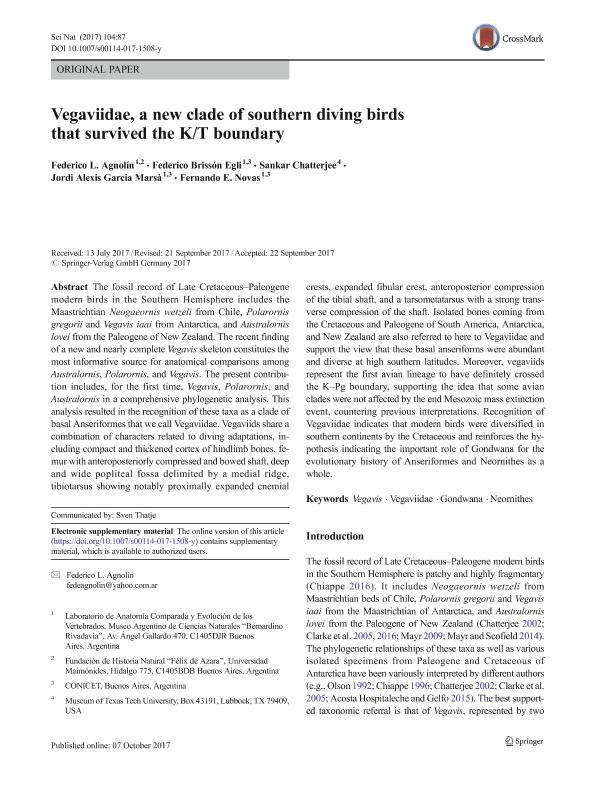Artículo
Vegaviidae, a new clade of southern diving birds that survived the K/T boundary
Agnolin, Federico ; Brissón Egli, Federico
; Brissón Egli, Federico ; Chatterjee, Sankar; García Marsa, Jordi Alexis
; Chatterjee, Sankar; García Marsa, Jordi Alexis ; Novas, Fernando Emilio
; Novas, Fernando Emilio
 ; Brissón Egli, Federico
; Brissón Egli, Federico ; Chatterjee, Sankar; García Marsa, Jordi Alexis
; Chatterjee, Sankar; García Marsa, Jordi Alexis ; Novas, Fernando Emilio
; Novas, Fernando Emilio
Fecha de publicación:
10/2017
Editorial:
Springer
Revista:
Naturwissenschaften
ISSN:
0028-1042
e-ISSN:
1432-1904
Idioma:
Inglés
Tipo de recurso:
Artículo publicado
Clasificación temática:
Resumen
The fossil record of Late Cretaceous-Paleogene modern birds in the Southern Hemisphere includes the Maastrichtian Neogaeornis wetzeli from Chile, Polarornis gregorii and Vegavis iaai from Antarctica, and Australornis lovei from the Paleogene of New Zealand. The recent finding of a new and nearly complete Vegavis skeleton constitutes the most informative source for anatomical comparisons among Australornis, Polarornis, and Vegavis. The present contribution includes, for the first time, Vegavis, Polarornis, and Australornis in a comprehensive phylogenetic analysis. This analysis resulted in the recognition of these taxa as a clade of basal Anseriformes that we call Vegaviidae. Vegaviids share a combination of characters related to diving adaptations, including compact and thickened cortex of hindlimb bones, femur with anteroposteriorly compressed and bowed shaft, deep and wide popliteal fossa delimited by a medial ridge, tibiotarsus showing notably proximally expanded cnemial crests, expanded fibular crest, anteroposterior compression of the tibial shaft, and a tarsometatarsus with a strong transverse compression of the shaft. Isolated bones coming from the Cretaceous and Paleogene of South America, Antarctica, and New Zealand are also referred to here to Vegaviidae and support the view that these basal anseriforms were abundant and diverse at high southern latitudes. Moreover, vegaviids represent the first avian lineage to have definitely crossed the K-Pg boundary, supporting the idea that some avian clades were not affected by the end Mesozoic mass extinction event, countering previous interpretations. Recognition of Vegaviidae indicates that modern birds were diversified in southern continents by the Cretaceous and reinforces the hypothesis indicating the important role of Gondwana for the evolutionary history of Anseriformes and Neornithes as a whole.
Palabras clave:
Gondwana
,
Neornithes
,
Vegaviidae
,
Vegavis
Archivos asociados
Licencia
Identificadores
Colecciones
Articulos(MACNBR)
Articulos de MUSEO ARG.DE CS.NAT "BERNARDINO RIVADAVIA"
Articulos de MUSEO ARG.DE CS.NAT "BERNARDINO RIVADAVIA"
Citación
Agnolin, Federico; Brissón Egli, Federico; Chatterjee, Sankar; García Marsa, Jordi Alexis; Novas, Fernando Emilio; Vegaviidae, a new clade of southern diving birds that survived the K/T boundary; Springer; Naturwissenschaften; 104; 87; 10-2017; 1-9
Compartir
Altmétricas



